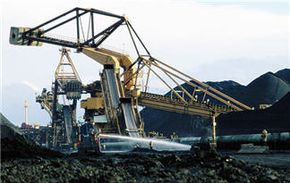Coal can be converted to liquid fuel using either direct or indirect liquefaction. Direct liquefaction isn't used in the U.S. because in order to comply with U.S. standards, the process prices itself out of practicality.
Indirect liquefaction -- the type of technology used in the U.S. -- involves two steps: first turning coal into a gas, a balanced mix of hydrogen and carbon monoxide called syngas. Then, the gas is turned into a liquid that is used as fuel. This is done most often through the Fischer-Tropsch process, which involves chemically refining the syngas to eliminate impurities, including sulfur and nitrogen, and converting it into either gasoline or diesel. This fuel is said to be cleaner than gasoline because it is sulfur-free.
In terms of greenhouse gas emissions, coal-to-liquid technology is extremely inefficient, particularly when coal is the sole feedstock and when the emissions are not captured. Without carbon capture technology, coal-to-liquid fuel produces twice the emissions as gasoline from conventional crude oil: about 50 pounds of CO2 for liquid coal compared with 27 pounds for conventional gasoline. Coal-to-liquid is also a water-intensive process, using about ten gallons of water for every gallon of fuel produced. According to the Argonne National Laboratory, gasoline production from crude uses between three and seven gallons of water for every gallon of gasoline produced.
Coal itself contains nearly twice the amount of carbon per unit of energy as natural gas, and about 20 percent more than petroleum. Then, turning coal into liquid fuel produces streams of carbon dioxide twice—at the plant and again when the fuel is consumed by a vehicle.
There is some debate over the technology's efficiency in cases where Carbon Capture and Storage is implemented. Most accounts, including a report by the EPA, say that even if 90 percent of emissions are captured, liquid coal still produces more emissions than gasoline, when total well-to-wheel emissions (from the point of extraction through consumption) are considered.
A study by the National Energy Technology Laboratory (NETL), however, found that when coal-to-liquid plants use carbon capture, the lifecycle emissions will be five to 10 percent lower than conventional petroleum.
What complicates the question further is that unless or until carbon capture is required or carbon emissions are legally capped, there is no guarantee that plants will actually capture their emissions—a technology that can increase costs by about $5 a barrel.
Things change, however, when biomass is added to the feedstock. According to the same NETL study, "Co-gasifying 30%, by weight, non-food source biomass with coal to produce diesel fuel further lowers the life cycle GHG emission to 4230% below the 2005 petroleum baseline," referring to calculations carried out that year.
But the use of biomass isn't cheap. According to the American Association for the Advancement of Science, the coal-to-liquid refinement process is ultimately three to four times more expensive than refining an equivalent amount of petroleum -- and when biomass is mixed with coal, the process becomes even more expensive.

